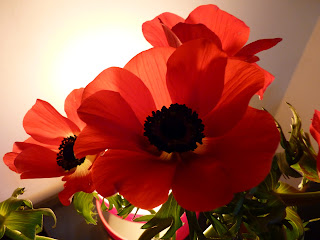anemone (n.)
Flowering plant genus, 1550s, from M.Fr. anemone (16c.) and directly from L. anemone, from Gk. anemone "wind flower," lit. "daughter of the wind," from anemos "wind" (cognate with L. anima; see animus) + -one feminine patronymic suffix.
 |
| © Alan Dicks, 2012 |
I bought this bunch of blood-red anemones yesterday for $5, from a great little dairy (newsagents) on Glenmore Street. It has a crazy selection of cut flowers, especially for a tiny dairy (which, incidentally, is two doors down from another which is almost exactly the same). Lilies. Irises. Orchids. Arums. Narcissi. And these wonderful anemones.
 |
| © Alan Dicks, 2012 |
I found out today that (for rather obvious reasons) they're called poppy anemones. They're also known as Spanish marigolds and anemone de Caen. Their Latin name, Anemone coronaria, presumably refers to their attractive ruff of leaves just below the flowers. While red appears to be the original colour, they now come in an array of primaries and pastels. They're easy to grow, and most nurseries will sell the de Caen hybrids.
 |
| De Caen hybrids |
The double-flowered varieties always strike me as a bit blowzy, but the singles are stunning. The red ones are particularly handsome. And they look great next to Danny's red retro lamp. I particularly love their simplicity (the buttercup family to which they belong is one of the world's most primitive); their unapologetically bold colouring; and their stiff, sinuous stems. It's just a shame about the name. It's not that anemone is an unpleasant word. But like 'thief' and 'championing', it's one I really struggle to pronounce. Perhaps I should start using the old vernacular name 'wind flower' instead?
 |
| A. coronaria in the wild (Shokeda forest, Israel) © Zachi Evenor |
Like buttercups, anemones grow in vast colonies. It's easy to see why the anemone fields of the Negev desert are famous. Their north European cousins are less vibrant, but certainly no less attractive. The springs of my childhood were spent in the anemone-carpeted woods of Kent. In early March, long before the bluebells were out, the forest floor would become white with wood anemones. I miss them a lot...
 |
| Wood anemones (A. nemorosa)at Milstead, Kent © Alan Dicks, 2010 |
No comments:
Post a Comment